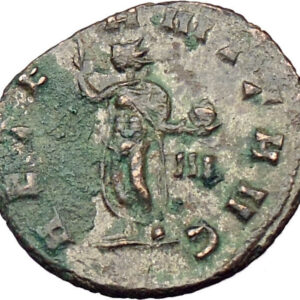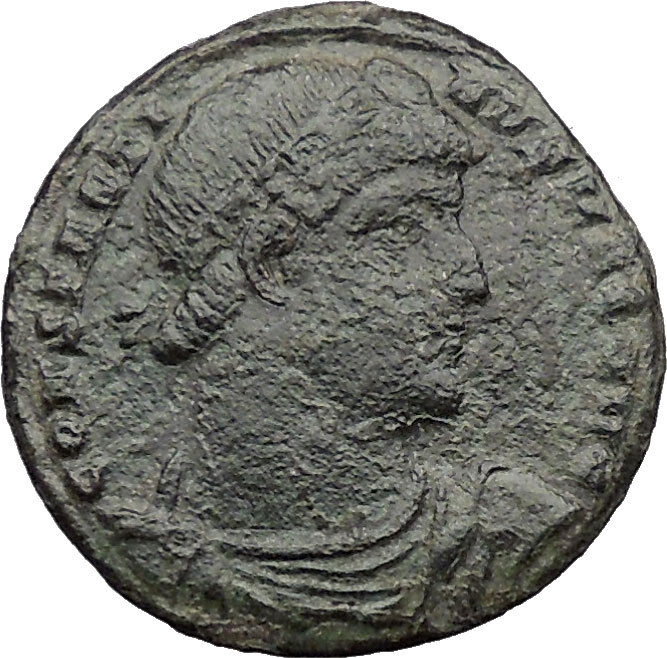|
Arcadius
–
Roman Emperor
: 383-408 A.D. –
Bronze AE4 16mm (1.13 grams) Nicomedia mint: 388-392 A.D.
Reference: RIC IX 37c
D N ARCADIVS P F AVG, pearl-diademed, draped, cuirassed bust right
VOT V within wreath. Mintmark SMNΓ
You are bidding on the exact item pictured,
provided with a Certificate of Authenticity and Lifetime Guarantee of
Authenticity.

In
ancient Roman religion
, Victoria was the
personified
goddess of victory. She is the
Roman equivalent
of the
Greek goddess
Nike
, and was associated with
Bellona
. She was adapted from the
Sabine
agricultural goddess
Vacuna
and had a
temple
on the
Palatine Hill
. The goddess
Vica Pota
was also sometimes identified with
Victoria.
Unlike the Greek
Nike
, the goddess Victoria (Latin
for “victory”) was a major part of Roman society. Multiple temples were erected
in her honor. When her statue was removed in 382 CE by Emperor
Gratianus
there was much anger in Rome. She was
normally worshiped by
triumphant
generals returning from war.
Also unlike the Greek Nike, who was known for success in athletic games such
as
chariot races
, Victoria was a symbol of victory
over death and determined who would be successful during war.
Victoria appears widely on Roman coins, jewelry, architecture, and other
arts. She is often seen with or in a
chariot
, as in the late 18th-century sculpture
representing Victory in a
quadriga
on the
Brandenburg Gate
in
Berlin
, Germany; “Il Vittoriano”
in Rome has two.
Winged figures, very often in pairs, representing victory and referred to as
“victories”, were common in Roman official iconography, typically hovering high
in a composition, and often filling spaces in
spandrels
or other gaps in architecture. These
represent the spirit of victory rather than the goddess herself. They continued
to appear after Christianization of the Empire, and slowly mutated into
Christian angels
.
Flavius
Arcadius (377/378–1 May 408) was
Byzantine Emperor
in the Eastern half of the
Roman
Empire
from 395 until his death.
//

History
Arcadius was born in
Hispania
,
the elder son of
Theodosius I
and
Aelia Flaccilla
, and brother of
Honorius
, who would become a
Western Roman Emperor
. His father declared him an
Augustus
and co-ruler for the
Eastern half of the Empire
in January, 383. His younger brother was also
declared Augustus in 393, for the Western half.
As emperors, Honorius was under the control of the Romanized
Vandal
magister militum
Flavius
Stilicho
while Arcadius was dominated by one of his ministers,
Rufinus
. Stilicho is alleged by some to have wanted control of both
emperors, and is supposed to have had Rufinus assassinated by Gothic mercenaries
in 395; though definite proof of Stilicho’s involvement in the assassination is
lacking, the intense competition and political jealousies engendered by the two
figures compose the main thread of the first part of Arcadius’ reign. Arcadius’
new advisor, the eunuch
Eutropius
, simply took Rufinus’ place as the power behind the Eastern
imperial throne.
Arcadius was also dominated by his wife
Aelia
Eudoxia
, who convinced her husband to dismiss Eutropius, who was holding the
consulate, at the height of his power, in 399. That same year, on the 13th July,
Arcadius issued an edict ordering that
all remaining non-Christian temples should be immediately demolished
.
Eudoxia’s influence was strongly opposed by
John Chrysostom
, the
Patriarch of Constantinople
, who felt that she had used her family’s wealth
to gain control over the emperor. Eudoxia used her influence to have Chrysostom
deposed in 404, but she died later that year. Eudoxia gave to Arcadius four
children: three daughters,
Pulcheria
,
Arcadia and Marina, and one son, Theodosius, the future Emperor
Theodosius II
.
Arcadius was dominated for the rest of his rule by
Anthemius
, the
Praetorian Prefect
, who made peace with Stilicho in the West. Arcadius
himself was more concerned with appearing to be a pious
Christian
than he was with political or military matters, and he died, only
nominally in control of his empire, in 408.
Character and works
In this reign of a weak emperor dominated by court politics,
a major theme was the ambivalence felt by prominent individuals and the court
parties that formed and regrouped round them towards
barbarians
,
which in Constantinople at this period meant
Goths
. In the
well-documented episode that revolved around
Gainas
, a
number of Gothic foederati stationed in the capital were massacred, the
survivors fleeing under the command of Gainas to
Thrace
, where
they were tracked down by imperial troops and slaughtered and Gainas dispatched.
The episode has been traditionally interpreted as a paroxysm of anti-barbarian
reaction that served to stabilise the East. The main source for the affair is a
mythology à clef by
Synesius
of
Cyrene, Aegyptus sive de providentia, (400)[1]
an Egyptianising allegory that embodies a covert account of the events, the
exact interpretation of which continues to baffle scholars. Synesius’ De
regno, which claims to be addressed to Arcadius himself, contains a tirade
against Goths.
A new
forum
was built in the name of Arcadius, on the seventh hill of
Constantinople, the Xērolophos, in which a
column
was begun to commemorate his ‘victory’ over Gainas (although the
column was only completed after Arcadius’ death by
Theodosius II
).
The
Pentelic marble
portrait head of Arcadius (illustration) was
discovered in Istanbul close to the Forum Tauri, in June 1949, in excavating
foundations for new buildings of the University at
Beyazit
.[2]
The neck was designed to be inserted in a torso, but no statue, base or
inscription was found. The
diadem
is a
fillet with rows of pearls along its edges and a rectangular stone set about
with pearls over the young emperor’s forehead.
|









